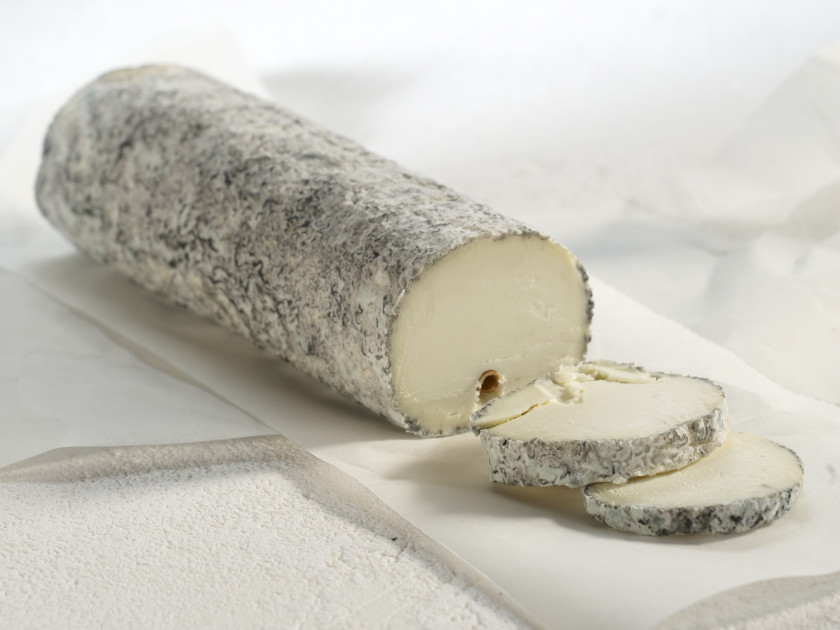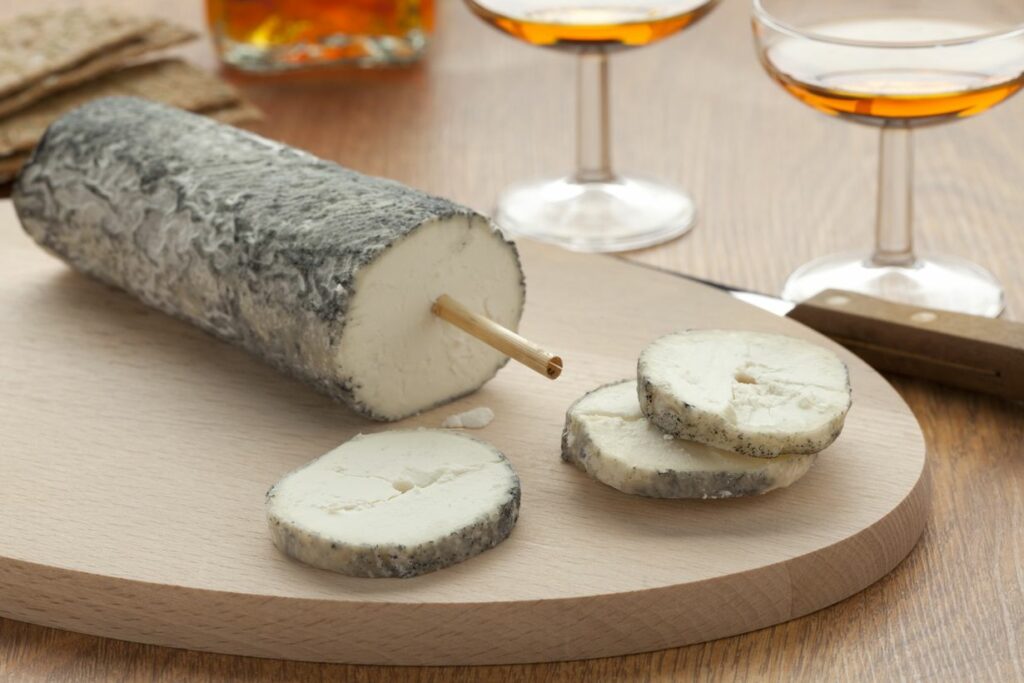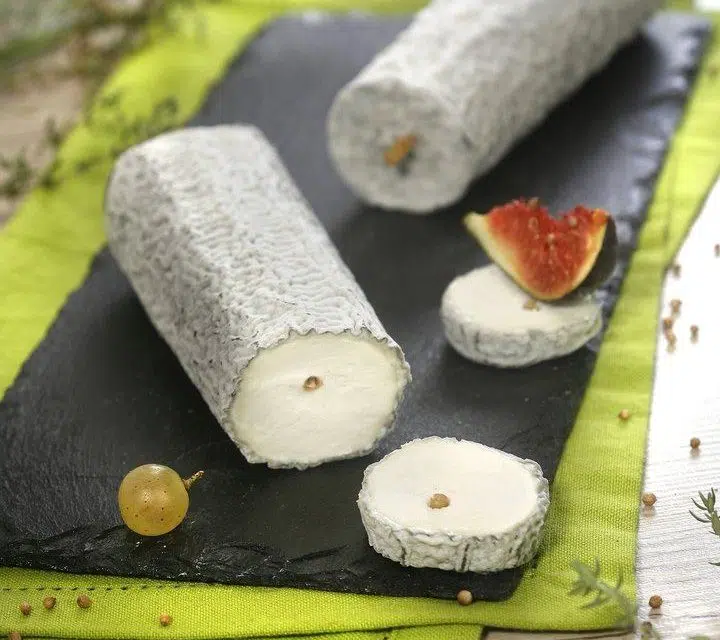What is Sainte-Maure de Touraine? France’s Iconic Goat Cheese
A jewel among the gastronomic treasures of France, Sainte-Maure-de-Touraine is a testament to the country’s rich cheese-making heritage. This iconic goat cheese, hailing from the Touraine region in the Loire Valley, is steeped in tradition and recognized for its distinctive cylindrical shape and straw core.
Encased in an edible, ash-covered rind, this cheese unveils a creamy, full-flavored interior that is both tangy and slightly nutty – a delightful contradiction of flavors that has captivated palates for centuries. Often enjoyed with a glass of local wine, Sainte-Maure-de-Touraine is not just a cheese, but a celebration of French culinary artistry.
Quick Facts About Sainte-Maure-de-Touraine
| Quick Facts | Details |
|---|---|
| Origin | Loire Valley, France |
| Cheese type | Soft, uncooked, unpressed |
| Made from | Goat’s milk |
| Texture | Creamy and smooth |
| Flavor | Nutty with a hint of acidity |
| Shape | Log-shaped, usually around 7 inches long |
| Distinctive feature | A straw running through the center for structural support |
| Aging time | Minimum of 10 days |
| Certification | Protected Designation of Origin (PDO) since 1990 |
| Pairings | Light red wines like Chinon, Bourgueil, or white wines like Vouvray, Montlouis; Baguette or rustic bread; Fresh fruits like apples, pears, or figs |
| Best season to consume | March to September, when the milk is richest |
What is Sainte-Maure-de-Touraine?

Sainte-Maure-de-Touraine is a celebrated cheese that hails from the Loire Valley in central France. Known for its distinctive log shape and the straw that runs through its center, this cheese is a symbol of French gastronomy and has a rich history dating back to the 9th century.
Made from full-fat goat’s milk, Sainte-Maure-de-Touraine is an unpasteurized cheese that boasts a soft pâte texture and a grey mold rind. It’s typically around 16-17 cm in length and carries a fat content of at least 45%. The straw in the middle not only gives it a unique look but also provides structural support to the cheese.
Sainte-Maure-de-Touraine is the second most popular goat’s cheese in France, only surpassed by Crottin de Chavignol. Despite its high production, it did not receive protection until 1990 under the Appellation d’Origine Contrôlée (AOC) system. This certification ensures the quality and authenticity of the cheese, preserving its traditional production methods.
The taste of Sainte-Maure-de-Touraine is as remarkable as its history. It offers a fresh and tangy flavor with a hint of lemony zest. Paired with a glass of Chenin Blanc from the same region, it makes for a delightful culinary experience.
Sainte-Maure-de-Touraine is more than just a cheese; it’s a testament to France’s rich dairy heritage and the skill of its cheesemakers. Whether you’re a cheese connoisseur or a curious foodie, tasting this cheese is like embarking on a gastronomic journey through the heart of France.
What Does Sainte-Maure-de-Touraine Taste Like?
Sainte-Maure-de-Touraine has a slightly salty and nutty flavor, often compared to the taste of walnuts, coupled with a refreshing lemony finish.
The rind of Sainte-Maure-de-Touraine is thin and smooth, featuring a blue-to-gray mold that adds to its distinctive look and taste. The age of the cheese can impact its flavor, with younger cheeses offering a milder taste that may not be as goaty.
Sainte-Maure-de-Touraine Tasting Notes

- Texture: The cheese has a soft and creamy texture that offers a pleasant sensation on the palate. It’s not too dense or heavy, which makes it perfect for spreading on bread or crackers.
- Flavor: Sainte-Maure-de-Touraine is known for its mildly salty and subtly nutty flavor, reminiscent of walnuts. It also has a refreshing citrusy note, often compared to a lemony zest.
- Rind: The rind of this cheese is thin and smooth, covered in a blue-to-gray mold. This contributes to the cheese’s complex flavor profile and gives it a distinctive look.
- Aging: The flavor of the cheese can change with aging. Younger cheeses tend to have a milder taste that’s less goaty, while older ones develop a stronger, tangier flavor.
- Seasonality: The best season to consume Sainte-Maure-de-Touraine is between March and September, when the goat’s milk is the richest. During this time, the cheese develops its most robust flavor profile.
How to Eat Sainte-Maure-de-Touraine?
- Room Temperature: To fully appreciate the flavors of Sainte-Maure-de-Touraine, it’s best to serve it at room temperature. Take it out of the refrigerator about an hour before serving to allow it to warm up.
- Slice Carefully: Because of its log shape, Sainte-Maure-de-Touraine should be sliced lengthwise rather than in rounds. This ensures that each slice includes a bit of the straw, which adds to the cheese’s unique flavor.
- Pairings: Pair Sainte-Maure-de-Touraine with crusty bread or crackers. Its creamy texture spreads well on these platforms and complements their crunchiness.
- Fruit Combinations: Fresh fruits like apples, pears, or figs can also pair beautifully with this cheese. The sweetness of the fruit contrasts nicely with the tangy, nutty flavor of the cheese.
- Wine Pairings: When it comes to drinks, light wines from the Loire Valley, such as Chinon, Bourgueil or white wines like Vouvray, Montlouis, complement this cheese perfectly.
- Salads and Cooking: Sainte-Maure-de-Touraine can also be crumbled over salads or melted into dishes for an added touch of gourmet flavor.
7 Best Sainte-Maure-de-Touraine Substitutes
| Cheese Name | Short Description | Flavor Profile |
|---|---|---|
| Valençay | A French goat cheese with a pyramid shape and a natural grey-blue mold. | Mild and fresh, with a slightly lemony tang. |
| Chabichou du Poitou | Another French goat cheese, cylindrical in shape and small in size. | Rich and nutty, with a slight tanginess. |
| Crottin de Chavignol | Small and round French goat cheese, known for its firm texture. | Nutty and creamy when young, becoming more intense with age. |
| Bucheron | Semi-aged French goat cheese, often sold in a log shape. | Mild and creamy with a tart, earthy flavor. |
| Selles-sur-Cher | A French goat cheese with a distinctive ash-coated rind. | Tangy and salty, with an earthy undertone from the ash rind. |
| Caprino | Italian goat cheese, available in both fresh and aged versions. | Delicate and milky when fresh, becoming sharper and more robust with age. |
| Chevre | General term for French goat cheese, available in many forms and styles. | Varies widely, but generally tangy, creamy, and slightly goaty. |
What Pairs Well With Sainte-Maure-de-Touraine?

Food that goes well with Sainte-Maure-de-Touraine:
| Category | Food |
|---|---|
| Bread | Crusty French baguette, whole grain bread, or artisan crackers |
| Fruit | Fresh fruits like apples, pears, and figs. Dried fruits such as apricots and raisins also pair well |
| Nuts | Walnuts, almonds, and hazelnuts provide a nice contrast in texture |
| Charcuterie | Prosciutto, salami, or other cured meats can balance the cheese’s creamy texture |
| Condiments | Honey, fig jam, or apple chutney can add a sweet contrast to the cheese’s tangy flavor |
| Salads | Mixed green salad with vinaigrette, beetroot salad, or arugula salad |
| Main Dishes | Quiche, tart, or pizza topped with Sainte-Maure-de-Touraine |
| Desserts | Pair it with dark chocolate or incorporate it into a cheese plate with other cheeses for a gourmet dessert |
Also read: 11 Best Crackers that Pair Well with Cheese
Beverage that goes well with Sainte-Maure-de-Touraine:
| Category | Beverage |
|---|---|
| White Wines | Loire Valley whites such as Vouvray or Montlouis |
| Red Wines | Light-bodied reds like Chinon or Bourgueil from the Loire Valley |
| Rose Wines | Rosé from Provence or the Loire Valley would offer a refreshing contrast |
| Sparkling Wines | A crisp, dry Champagne or Prosecco can balance the creaminess of the cheese |
| Beers | Belgian-style Saison, or wheat beers, which have a lightness that complements the cheese |
| Ciders | Dry apple cider, particularly those from Normandy or Brittany in France |
| Non-Alcoholic | Sparkling water or light, fruity non-alcoholic cocktails |
Also read: Best Wine and Cheese Pairings: The Ultimate Guide
Frequently Asked Questions
1. Is the rind of Sainte Maurice de Touraine edible?
Yes, the rind of Sainte-Maure-de-Touraine is edible. It’s usually covered in a fine gray mold, which is a natural part of the cheese-making process and is safe to eat. However, the texture and flavor may not be to everyone’s liking. Some people prefer to remove the rind before eating, while others enjoy the extra complexity it adds. As with any cheese, you should make sure it looks and smells fresh; if the rind is excessively moldy or has an off smell, it’s best not to eat it.
2. How to pronounce Sainte-Maure-de-Touraine?
The French cheese Sainte-Maure-de-Touraine is pronounced as “Sant-more-deh-Tour-en”. Please note that pronunciation can vary slightly based on regional accents.
Also read:
- What is Rigotte de Condrieu? A Gem from the Lyonnaise Region
- What is Chabichou du Poitou? The Zesty, Grassy Cheese of France
- What is Fourme de Montbrison? The Gentle Blue From Southern France
- What is Crottin de Chavignol? The Jewel of the Loire Valley
- What is Pélardon? A Taste of the French Countryside in Every Bite
- What is Saint Nectaire? A Taste of the Auvergne Region’s Volcanic Pastures
- What is Pouligny-Saint-Pierre? A Taste of Central France in Every Bite





